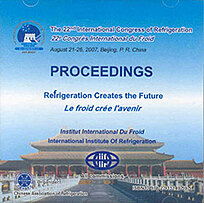
Document IIF
Conductivité thermique de la glace fragmentée.
Thermal conductivity of controlled ice-fraction materials.
Auteurs : CARSON J. K., WANG J. F., WILLIX J., et al.
Résumé
Effective thermal conductivity predictions for frozen products require both an ice fraction model and an effective thermal conductivity model; hence there are two degrees of freedom when comparing model predictions to experimental data for real foods, which can lead to misleading conclusions. To avoid ice fraction prediction uncertainties, thermal conductivity was measured for two types of ice samples (ice chips produced by a commercial ice maker, and synthetic snow) in which the ice and air fractions were controlled. Levy's effective thermal conductivity model provided reasonable predictions for the ice-chip data, although greater accuracy was obtained using a composite effective medium theory and co-continuous model. The Maxwell-Eucken model provided reasonable predictions for the synthetic snow data; however, systematic error in these measurements may have been significant.
Documents disponibles
Format PDF
Pages : ICR07-C2-536
Disponible
Prix public
20 €
Prix membre*
Gratuit
* meilleur tarif applicable selon le type d'adhésion (voir le détail des avantages des adhésions individuelles et collectives)
Détails
- Titre original : Thermal conductivity of controlled ice-fraction materials.
- Identifiant de la fiche : 2008-0270
- Langues : Anglais
- Source : ICR 2007. Refrigeration Creates the Future. Proceedings of the 22nd IIR International Congress of Refrigeration.
- Date d'édition : 21/08/2007
Liens
Voir d'autres communications du même compte rendu (839)
Voir le compte rendu de la conférence
Indexation
- Thèmes : Congélation des aliments
- Mots-clés : Conductivité thermique; Produit alimentaire; Mesure; Produit congelé; Glace divisée
-
Alternative models to predict the thermal condu...
- Auteurs : WANG J. F., CARSON J. K., NORTH M. F., et al.
- Date : 16/02/2006
- Langues : Anglais
- Source : Innovative Equipment and Systems for Comfort and Food Preservation.
- Formats : PDF
Voir la fiche
-
SIMULTANEOUS DETERMINATION OF THERMAL CONDUCTIV...
- Auteurs : DOMINGUEZ M., et al.
- Date : 10/08/1991
- Langues : Anglais
- Source : New challenges in refrigeration. Proceedings of the XVIIIth International Congress of Refrigeration, August 10-17, 1991, Montreal, Quebec, Canada.
- Formats : PDF
Voir la fiche
-
Modelling thermal conductivity of frozen foods ...
- Auteurs : TARNAWSKI V. R., BOVESECCHI G., COPPA P., et al.
- Date : 21/08/2007
- Langues : Anglais
- Source : ICR 2007. Refrigeration Creates the Future. Proceedings of the 22nd IIR International Congress of Refrigeration.
- Formats : PDF
Voir la fiche
-
Predicting the thermal conductivity of low wate...
- Auteurs : CARSON J. K., WANG J. F., NORTH M. F., et al.
- Date : 21/08/2011
- Langues : Anglais
- Source : Proceedings of the 23rd IIR International Congress of Refrigeration: Prague, Czech Republic, August 21-26, 2011. Overarching theme: Refrigeration for Sustainable Development.
- Formats : PDF
Voir la fiche
-
Studies on ice nucleation and recrystallization...
- Auteurs : REID D. S., ZHAO J., WADA Y., KERR W. L.
- Date : 20/08/1995
- Langues : Anglais
- Source : For a Better Quality of Life. 19th International Congress of Refrigeration.
- Formats : PDF
Voir la fiche
